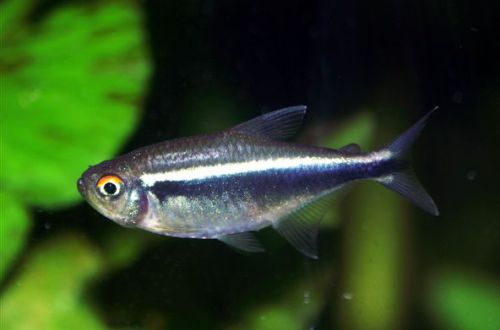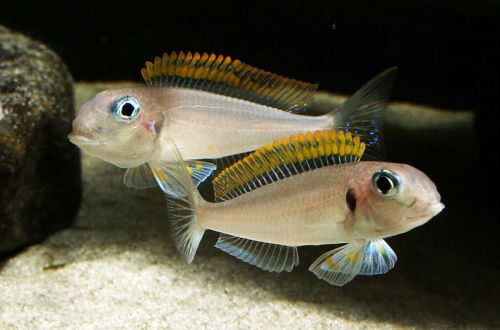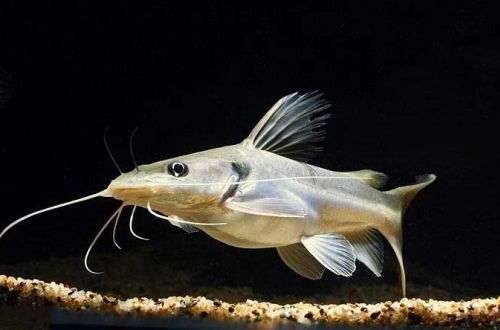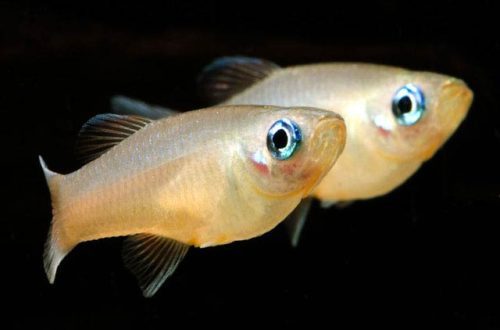
Black Neon
Black Neon, scientific name Hyphessobrycon herbertaxelrodi, belongs to the Characidae family. A beautiful and very energetic fish with a bright stripe on its side, like a neon touch, if you place a small flock in a large aquarium with algae and a dark background, you can see a beautiful show – “neon sparks” with good lighting.

Habitat
Black Neon first received a scientific description relatively recently in 1961, found in slow-flowing rivers, stagnant reservoirs in Brazil, Bolivia and Paraguay. Currently, they are no longer caught in the wild, as Neons have successfully acclimatized in home aquariums.
In the wild, these fish prefer small tributaries, streams, areas of flooded forests and sandbars. Their natural habitat is typically acidic water that turns brown from chemicals released from decaying organic materials.
Description
The fish are small compared to other tetras, reaching a length of only about 4 cm in a home aquarium. The color is predominantly gray or dark silver with two distinct stripes of black and white, stretching from head to tail. The white stripe has a special pigmentation with high reflectivity, which creates a sensation of glow – “neon light”.
Food
An omnivorous species, therefore, in the diet you can find all types of live, vegetable, as well as dry food. To maintain a balanced diet, they need to be fed quality dry food daily. You can also dilute the diet with live (eg, bloodworm, daphnia) or frozen food.
Maintenance and care
Black Neons do not require special care, provided that they are kept clean and the water in the aquarium is changed frequently. At least 25-50% of the total should be changed every two weeks. Of the equipment, it is recommended to use a filter with a filter element made of peat, an aerator, a heater, lighting devices with low power.
The fish thrive best in soft, slightly acidic water with cover for cover and gravel on the bottom of the tank. As a substrate, you can use river sand with bark or tree branches. You can add dry leaves to the water, which will give the water a light brown tint. Replaced after a few weeks. Use subdued lighting to improve coloration, floating plants create additional shade.
Social behavior
The fish is ideal for coexistence with other non-predatory species of suitable size. These are very active and peaceful fish, one of the best for breeding in an aquarium. They are best purchased in a group of 7 individuals or more, they live freely both in pairs and in groups.
Breeding / breeding
Spawning is carried out in a separate tank, because the fish are prone to eating their young. A spawning aquarium of 20 liters is enough, a weak filter is enough from the equipment. The design uses groups of low plants and sandy soil. Water composition: pH 6.0, soft (4 dH), temperature not lower than 26°C.
Spawning can begin at any time, the stimulus for it is feeding meat products (bloodworm). When the female has a big belly, then it’s time to transplant the couple into a separate tank, after a while the female releases eggs into the water, and the male fertilizes it. All this happens above the thickets of plants, where the eggs subsequently fall. If the plants are located in several groups, the pair will spawn in several zones at once. At the end of the fish return to the general aquarium.
The spawning aquarium is covered with a towel for a couple of days, during which time fry appear. After that, the light must be turned on and the towel removed, otherwise the fry cannot find food in the dark and will die. Feed powdered food, Artemia nauplii.
Diseases
In good conditions, the risk of disease is very low, in other conditions they are prone to typical diseases of tropical fish. Read more about symptoms and treatments in the Aquarium Fish Diseases section.





